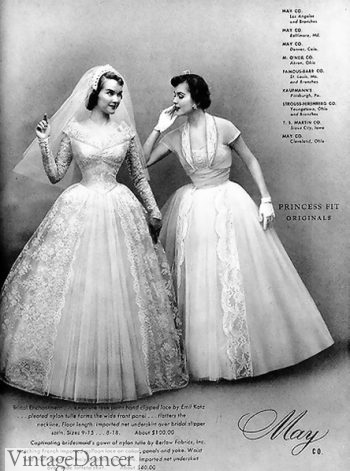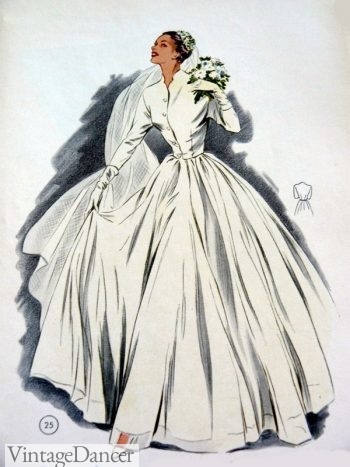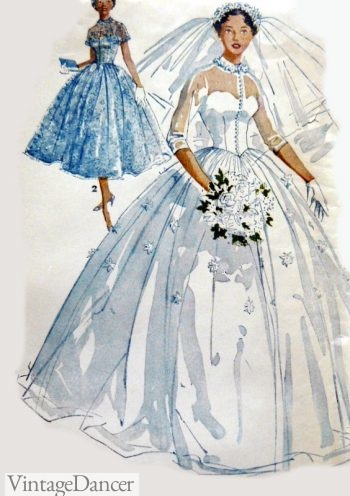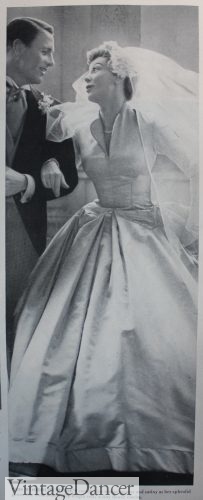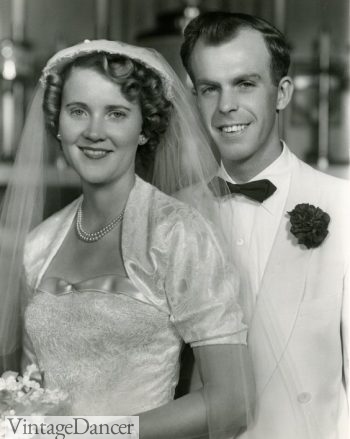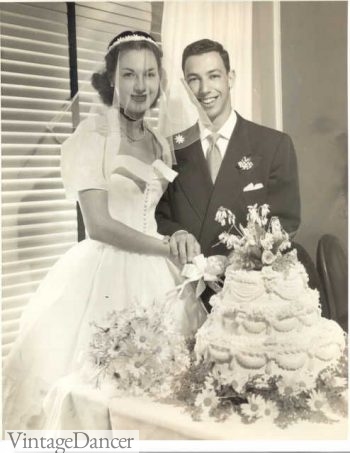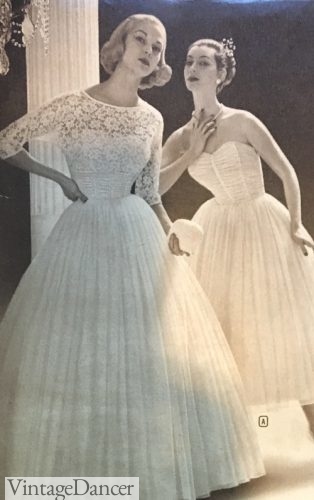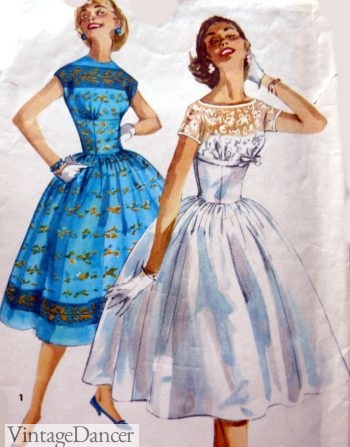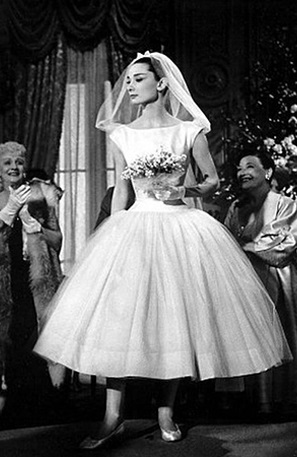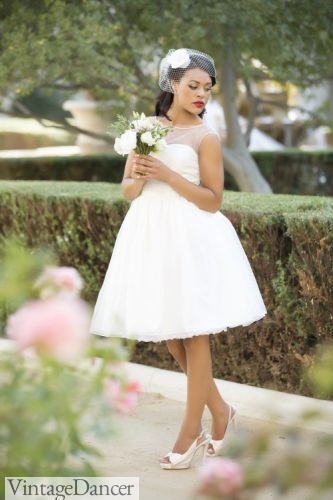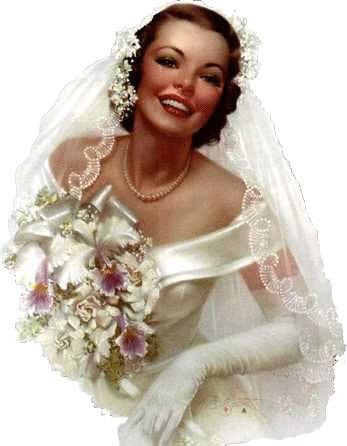
The blushing bride
Coming out of the 1940s, women were looking to high fashion designers and their Hollywood models for fashion inspiration. The 1950s vintage wedding dress was no different. Brides-to-be flocked to bridal salons inside department stores, where they viewed the latest runway wedding gowns, veils, and flowers as well dedicated areas for menswear, housewares, and bridesmaid dresses. The day-long event set the tone that weddings were a high fashion affair.
Brides were encouraged to dress like the Hollywood stars in the most expensive gown they could afford. Thanks to manufacturing improvements, wedding dresses were now being offered “off the rack” with cheaper synthetic materials that looked as expensive as the real thing. Every bride could afford a dream wedding in a dream wedding gown complete with accessories and live happily ever after… or so they said.
Early 1950s Wedding Gowns
The sweetheart neckline, small waist, and full skirt was the classic wedding gown silhouette for most of the 1950s. Early ’50s fabrics embraced a structure that easily molded the torso and shaped the hips down to the floor. Ribbed silks and Duchesse satins were smooth and shiny. Lace was both a top only and full-dress fabric infused with gold or silver thread. Handmade lace was very soft and expensive, but new cotton or polyester-cotton machine made lace was crisp and affordable. Lace was used heavily in ’50s wedding attire, from the gown to veils to gloves.
- 1953 lace wedding gowns
- Elegant long sleeve full wedding gown
- Sheer top modest wedding dress
- 1952, modest long sleeve satin wedding down
Full modesty in churches was required, meaning sleeves were long with some fullness at the top, a tight fit down to the wrist, and a medieval style cuff. Necklines favored the higher cuts of V, bateau, sweetheart, and scalloped shapes. The skirt hung from the high waistline in an A-line shape, supported by one long petticoat underneath.
Mid 50s Wedding Dresses
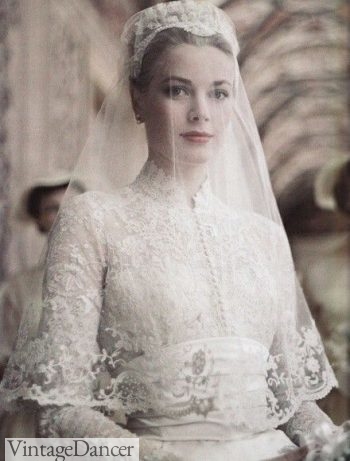
Grace Kelly wears a skin tight long sleeve lace wedding gown for her church wedding to Prince Rainier. See it on display.
Mid ’50s wedding gowns saw some practical changes in the area of reception gowns. Modesty was required in churches, but brides wanted something modern and fashionable. Wedding dress designers solved this dilemma with removable layers. Most bridal gowns were now strapless but also had a matching bolero jacket with three-quarter length sleeves that were worn at the ceremony. Jackets could be solid silk or satin, but more often were white lace, tightly fitted as if it were a second skin. Another option was to have detachable sleeves that came off for the reception. It wasn’t entirely acceptable to wear a sleeveless gown to the ceremony until the ’60s. Even short sleeve jackets were a controversial style, but women wore them anyways.
- Short sleeves bolero jacket wedding dress
- Bolero jacket over sleeveless wedding gown
In the mid ’50s, a TV show called Bride and Groom featured real couples who married in the studio’s faux chapel on national TV. They were given wedding rings, household gifts, a honeymoon, and a rental car to start their life together. Only a few episodes remain, but they are priceless. Watch them here, here, here and here.
Late 1950s Wedding Dresses
Mid to late ’50s dresses softened up the shape into the round ballgown, using chiffon and tulle to make them lighter as well. Hemlines rose up, up, and up to the tea length (ankle) or mid shin, exposing footwear for the first time since the ’20s. Audrey Hepburn wore a ballerina style wedding gown in Funny Face in 1957, dancing and twirling and showing off how light and magical the calf length dress was. The bodice styles simplified, too. Short sleeves were preferred. Plain, wide, and round necklines without collars or halternecks gave the look some doll-like innocence.
- Lace and tulle long or tea length wedding dresses
- Tea length, short sleeve wedding dress
- Party dress or wedding dress? They looked identical in the late 50s
- 1957, Audrey Hepburn’s Tea Length Wedding Dress in Funny Face
Types of wedding dress necklines:
Wedding dress skirts of the ’50s had little variety, but the necklines embraced nearly every shape imaginable.
- Bateau – cut straight across the collarbone in front and equally in the back with a one inch gap at the shoulders. See Audrey Hepburn in Funny Face (1957).
- Fichu – A frilled fichu gathered into a point at the breasts. Sometimes a brooch or flower was placed at the point.
- Halter – Thick straps gathered from the side of the breast up and around the back of the neck. The most acceptable of the sleeveless styles.
- Horseshoe – U shaped halter that loops under the bustline. A favorite style often called a shelf top today.
- Jewel – Simple round neckline, perfect for showing off jewelry.
- Off the shoulder – A boat neckline that falls just slightly off the shoulder with short sleeves.
- Portrait – A collar that frames the neck and shoulders.
- Queen Anne – A high back and neck that curves down into a sweetheart front. Very regal.
- Scoop neck – A wide and low U shaped neckline.
- Square neck – Straight sides and bust line, no cleavage.
- Strapless – A supported (boned) top with a straight bustline, often paired with a bolero or crop jacket.
- Sweetheart – A center point at the bust bowls out over the breasts and straight up the sides. A sheer lace, chiffon, or net illusion panel may be added for modesty. It is universally flattering.
- V- neck – Wide or narrow V opening from neck to bust or neck to low back. Sometimes with a peel out collar. Usually a narrow opening for modesty.
Famous 1950s Wedding Dresses
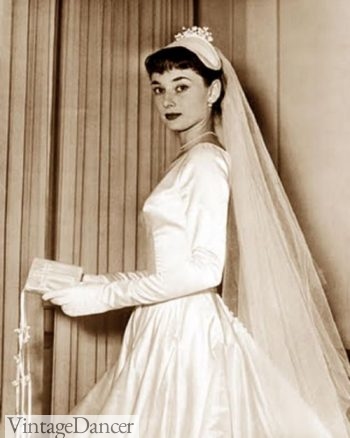
1954, Audrey Hepburn’s first wedding dress
Audrey Hepburn’s real wedding gown in 1954 had a full tea length skirt, high collar, small buttons down the center, billowing elbow length sleeves, and a wide sash around her waist. It enveloped her tiny figure.
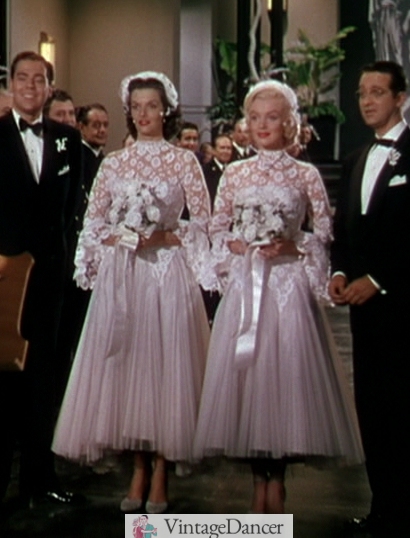
Gentlemen Prefer Blonds wedding dresses worn by Marilyn Monroe and Jane Russell
In Gentlemen Prefer Blonds, identical lace wedding dresses were worn by Marilyn Monroe and Jane Russell. Notice how they were adapted to each model. Marilyn, being more petite, has a slimmer skirt and shorter hem.
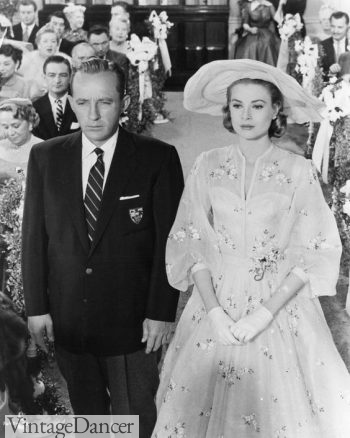
1956 Grace Kelly sheer floral wedding dress is The Philadelphia Story
In 1956, Grace Kelly wore a unique wedding dress while playing Tray Samantha in High Society, a musical remake of The Philadelphia Story. The dress was designed was Helen Rose, Ms. Kelly’s designer for her own wedding dress that same year.
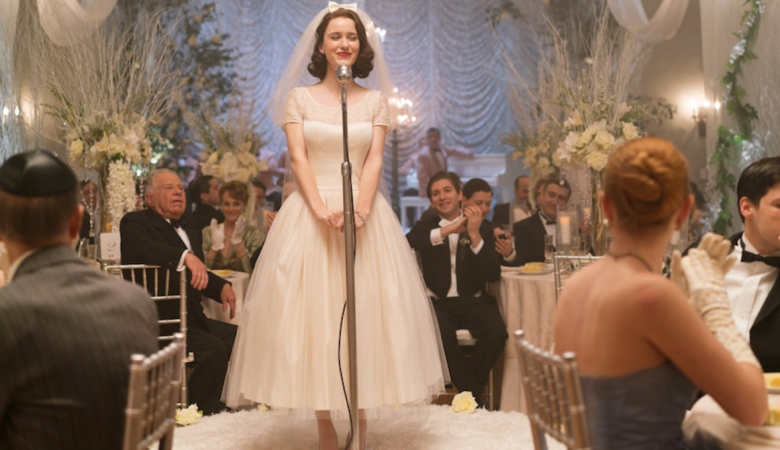
The Marvelous Mrs. Maisel Wedding Dress – Young, child-like, tea length tulle dress
Recently famous is the vintage ’50s wedding dress worn in the Marvelous Mrs. Maisel TV series. There has been a lot of enthusiasm for this darling, simple ’50s tea length wedding dress with a sheer scoop neck top, short sleeves, satin bodice, and tulle skirt. It is very ballerina-like, which fits perfectly in this time period. It is also a very popular vintage wedding dress style right now. If you love it, you can get one for yourself.
Modest 50s Weddings
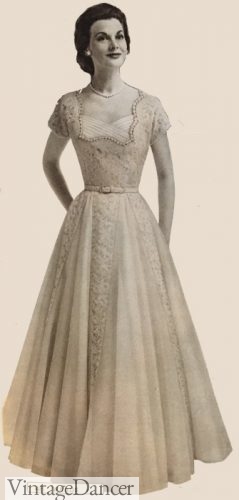
1956 ladies tulle and lace ball evening gown or wedding gown?
Not all brides wanted or could afford a lavish wedding with a couture wedding gown. Many brides opted for a small church ceremony with a reception at home wearing her best afternoon dress or tailored suit. Many brides made new dresses for this occasion or had experienced family members help sew a wedding gown from a pattern and special order fabric. Other brides re-used old heirloom wedding dresses and refashioned them into newer ’50s styles. Young brides may have re-worn a prom dress or borrowed one of the mother’s formal gowns. Ladies’ formal gowns were quite similar to wedding dresses. Some brides chose an ivory, pink, or yellow lace wedding dress because they could wear it again to a fancy party or night out to dinner and dancing. They were practical and affordable choices for brides with a mind on their future, not just the wedding day.
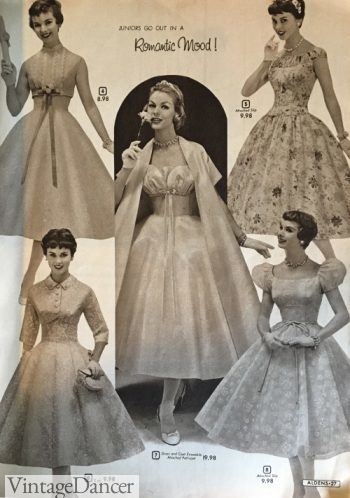
1956 lace prom dresses that could easily be wedding dresses
Wedding Veils, Hats and Tiaras
The wedding tiara was still worn in the ’50s but was quickly being replaced by small hats. Saucer shaped hats covered with beading and flowers were pulled down low on the forward creating a halo effect. There were also crescent shaped hats that saddled the head but left room for the latest bouffant hairstyles to shine.

Debbie Reynolds wore a crescent wedding hat with veil in 1955
When Queen Elizabeth was crowned in 1953, there was a brief revival of jeweled crowns to be worn instead of hats. Some brides, like Audrey Hepburn, wore a crown of roses instead.
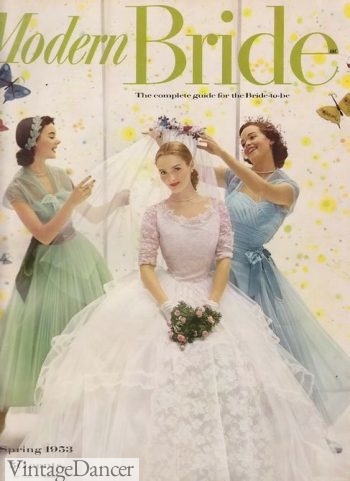
1953 Modern bride showing off the latest trend for flower crowns for both brides and bridesmaids
Veils were the one item that was “old,” usually being passed down from mothers and grandmothers. Long lace veils floating down the backs of wedding gowns added a classic touch to an otherwise modern wardrobe. Jackie Kennedy wore her grandmothers rosepoint lace veil attached to a small tiara of lace and orange blossoms. It contrasted nicely against her ivory silk taffeta ballgown (that she hated) with its ruched bodice and off the shoulder neckline. Long veils were often “updated” with crowns of small flowers, or were draped over a plain pillbox hat.
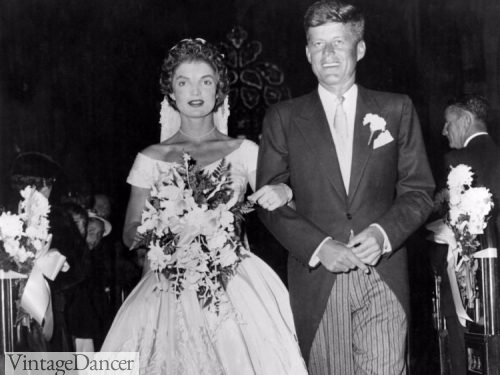
Jackie Kennedy holding her wedding flowers and wearing her mother’s lace veil
In the late 1950s, those who did not wear an heirloom veil wore a shoulder- to waist-length tulle veil that echoed the big ballgown skirt below. Attached to a hidden headband, small hat, or comb, layers of the tulle or net fluffed out from the head, mimicking the hairstyle, or rather protecting the hair from the weight of a traditional long veil. Rock n’ Roll brides wore a bouffant veil with a single rose placed at the center of the head.
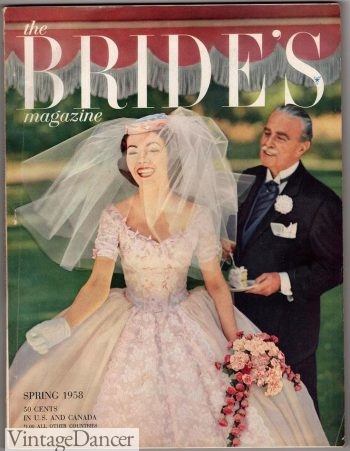
1958 Short tulle wedding veil on a hat
Accessories
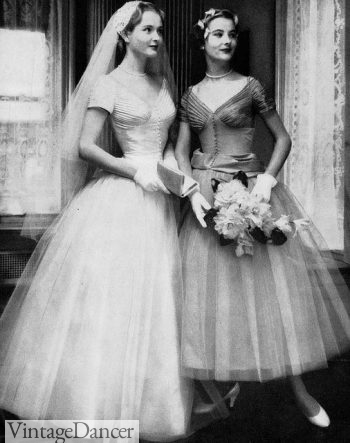
1953, short gloves for brides and bridesmaids
Gloves were equally as elegant as the dress. In the early years, a short sleeved gown would be paired with over the elbow or at-elbow doeskin white gloves that wrinkled at the wrists. Long sleeve gowns didn’t need gloves, but a pair of wrist length or fingerless gloves in satin, lace, or tulle was a nice touch.
Most of the ’50s favored short, wrist length white gloves in materials matching the dress. They paired well with short sleeve tea length dresses the best. Only about 1/4 of all brides chose to wear gloves. Shop gloves.
Jewelry was minimal. A short, single strand pearl necklace was often worn with low neck dresses. A matching pearl bracelet was a nice addition, especially if it was “something borrowed.” Pearl clip-on or stud earrings may have been worn on the ears if they were not covered up by hair. Shop jewelry.
Flowers. Lily of the Valley and fern or a single stem white Lily was tied in a white satin bow. Elizabeth Taylor chose yellow daffodils and tulips to match her bridesmaid’s yellow chiffon dresses. Jackie Kennedy carried a spray of white and pink orchids and gardenias. Anything pink was highly fashionable in wedding flowers for most of the decade, such as the pink roses and dahlias below.
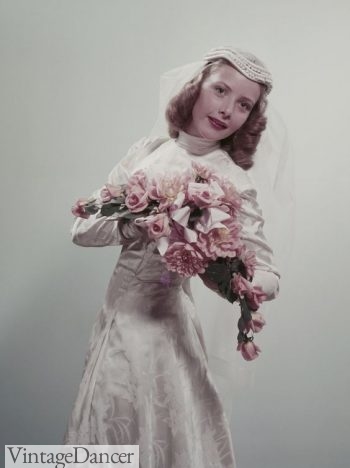
1955 wedding flowers of pink rose and dahlias
1950s Wedding Shoes
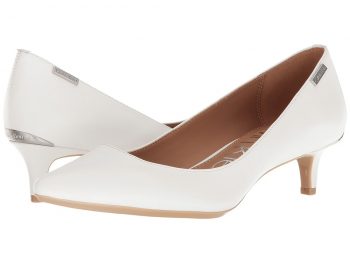
These CK kitten heels are ideal for a 50s wedding shoe
Cuban or kitten heels with a rounded toe in white was the classic wedding shoe. There was little need to wear anything else. Anything fancier, open-toed, strappy, or otherwise more “interesting” would detract from the bride and her wedding dresses. Shoes had to be simple. However the shorter the dress, the taller the heels. High heels shaped the now exposed calves into something attractive. The ultra thin stiletto heel did a nice job of that in the late ’50s. Nude stockings (with nude seams) helped hide unsightly leg hair.
Shop 1950s style wedding dress here and accessories such as veils, hats, gloves here.
What did you/your mother/grandmother wear to her wedding in the 1950s? Let me know in the comments below.
Debbie Sessions has been teaching fashion history and helping people dress for vintage themed events since 2009. She has turned a hobby into VintageDancer.com with hundreds of well researched articles and hand picked links to vintage inspired clothing online. She aims to make dressing accurately (or not) an affordable option for all. Oh, and she dances too.
